Plant Care
Everything You Need to Know About Monstera Plants
Monstera Plant: Growing and Caring for Monstera
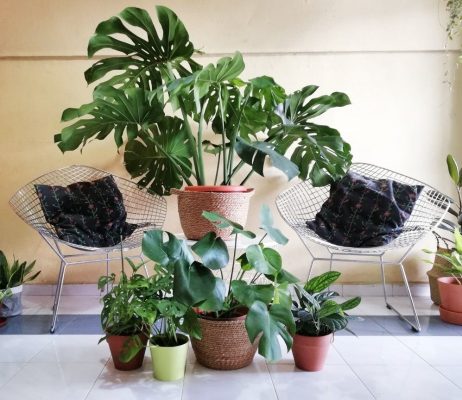
Monstera is a plant that is easy to care for provided that it is in the right environment and care. If you want it indoors, it has to have enough space to grow tall and bigger. The distinct appearance of the plant, the holes on the leaves, and the long ribbon-like design, make it look like a Swiss cheese.
Monstera plant is native in the tropical rainforests, specifically in south of Mexico. However, it can thrive well in indoor spaces with bright and indirect light, and warm and humid environment. Monstera plants can adapt easily, but to allow them to grow well, it needs space for the vines to climb up and leaves to stretch out.
What Is a Monstera Plant?
Family Name: Arum
Botanical Name: Monstera Deliciosa
Plant Description:
Monstera Plant is a vining plant that has unique features. The leaves are dramatic because of the holes. The plant is adored for its stunning huge leaves. It loves to climb the trellis and stakes or just trail over its pot.
Monstera loves the bright, indirect light from the sun or from the fluorescent lights. The impressive features of this plant, and its easy-to-maintain requirements make it an ideal houseplant to care for at home.
Interesting Facts:
The holes and patterns on the leaves of Monstera plant are “leaf fenestrations” or designs on the leaf. It is one feature distinct and unique in Monstera plants.
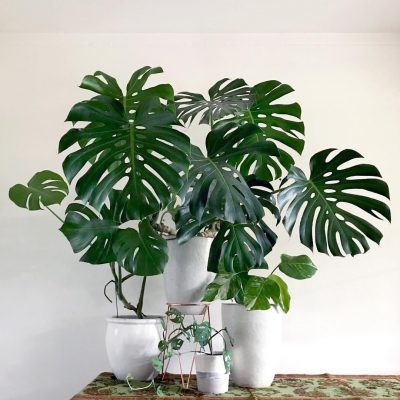
How to Grow and Care for Monstera Plant?
Use this guide and instructions on how to care for your Monstera Plant at home. The guide is about the requirements of the plant in terms of light, moisture, temperature, water, humidity, and some additional care for its growth.
Monstera Deliciosa
· LIGHT
Monstera Plants need light in order to grow big and huge faster. However, it can tolerate low to medium light, thus it can grow anywhere inside the house or office. Direct sunlight and too much exposure on bright light , on the other hand, may cause sunburn on leaves
· WATER
Monstera Plant requires water on well-drained soil. If the soil is already 50-75% dry, it is time to give the plant a thorough watering, but let the plant drain well and pour out any leftover water on the saucer.
· HUMIDITY
Monstera Plant loves the humidity but it can thrive in any kind of environment. However, if you want the plant to be at its best and for it to grow faster, let it enjoy the humidity by misting the plant with water in the morning.
· FOOD
Monstera Plant needs plant food for best results. You can feed it once a month during the spring and summer season, but not in winter season, especially in the colder months to allow the plant to rest. By giving the plant some fertilizers during the growing months, the roots will grow healthier.
· ADDITIONAL CARE
Monstera Plant is known for its large, monstrous leaves patterned with holes. Because of its size, it can easily collect dust and become dirty. To care for the leaves and make them shiny, you can use damp cloth and wipe off the dust.
· TOXICITY
Monstera Plant is also known to contain mild toxins on its leaves. They can be toxic to humans and pets when ingested, but only in mild level.
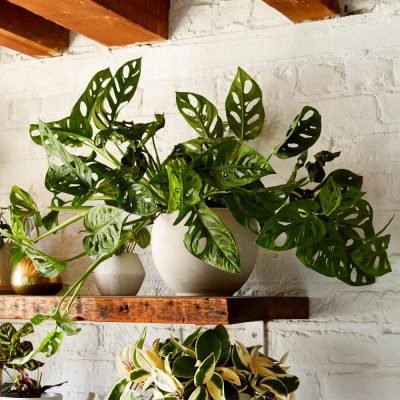
Monstera Adansonii
· LIGHT
Monstera Adansonii plant is a typical tropical plant that loves the bright light but not the direct light from the sun because the sun will burn its leaves. It can thrive in low light but on slow growth.
· WATER
Monstera Adansonii likes water when the soil is 75% dry. However, it does not want too much water sitting on its soil because it will rot the roots and kill the plant.
· HUMIDITY
Monstera Adansonii thrives in any conditions, even in spaces with low humidity. But if you want the plant to be at its best, or if you want to maximize its beautiful, stunning huge leaves, you can choose to add a humidifier near the plant or a pebble tray, aside from misting the plant in the morning to increase humidity.
· TEMPERATURE
Monstera Adansonii prefers a temperature between 60-80 degrees. Temperature below 60 is not good for the plant, and so does the sudden temperature drop.
· FOOD
Monstera Adansonii needs food once a month to gain strength and to be healthy. However, it is best to feed the plant on spring and summer season and allow the plant to rest on winter months.
· TOXICITY
Monstera Adansonii contains mild toxicity level and may cause mild effects on pets and humans. Ingestion of its leaves can be the cause of vomiting, and irritation.
· ADDITIONAL CARE
Monstera Adansonii loves to climb and stretch out its vines. By providing stakes or trellis, you can help the plant grow at its best.
Why are the leaves on my Monstera turning yellow?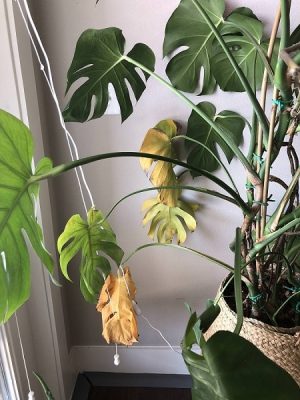
Is your Monstera leaf turning yellow? The leaves turn yellow for a number of reasons. Here are the possible reasons why:
· Improper Soil Moisture
Monstera Plant needs water but the moisture should not sit still on the soil. Overwatering and improper moisture cause the roots to rot, thus the color of the leaves turn yellow. To keep the plant in proper moisture, water it when the well-drained soil is dry. The plant enjoys damp soil but not wet soil.
In watering the Monstera plant, make sure that the soil is well-drained, the pot has excellent drainage holes, and no water sits still in the saucer. If there is leftover water in the saucer, discard it off to prevent root rotting. This type of plant does not want the “wet feet” condition.
In caring for Monstera plant, it is important to give it proper moisture. It is best to provide it with consistent watering because inconsistent watering will only cause stress on the plant, making it weak and prone to diseases.
· Unstable Humidity Level
Monstera plant benefits well from stable humidity level, but when humidity is low, the soil becomes dry and it affects the plant. It causes the leaves to turn yellow. However, this problem can be fixed by providing a pebble tray or humidifier to increase and stabilize the humidity level.
· Improper Lighting
Monstera plant wants b right but indirect sunlight, but it can thrive in low to medium light as well. When exposed under direct sunlight, the leaves will turn yellow and burn. However, it is also important that the plant receives bright light, especially if you want it to grow big and healthy. The plant can thrive in low light, but the growth is slow. The worst thing about it is that the leaves turn yellow and eventually fall due to weakness.
· Pests and Insect Infestation
Monstera plants are prone to pests and diseases, especially if they are grown indoors, in low light areas, and in low-temperature environment. Pests and insects love to suck its leaves, especially when the plant is weak. Spider mites, scale, and mealy bugs are among the pests that love to feed on the Monstera plants. Pests and insect infestations can be treated easily by removing them away from the leaves usingyour bare hands, a toothpick, or a stick. You can also spray neem oil and insecticidal soap solution on the plants to prevent pests from coming back.
· Yellow Leaves are Normal
It is normal for the Monstera plant leaves to turn yellow when new growth sprouts at the bottom. The yellow leaves are a sign that the plant is maturing and reproducing.
Why are the leaves on my Monstera limp and drooping?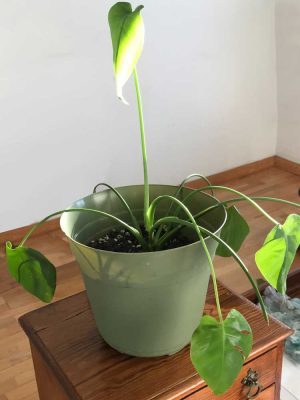
Another problem that is usually encountered in caring and growing Monstera plant is that its leaf goes limp and drooping. When this happen, you can do something to fix it and help the plant survive.
· Moisturize the Dry Soil
One reason why leaves go limp and droop is because of dry soil. To fix it, all you need to do is to keep the soil moist but not wet. Once you see that the soil is dry from 2-3 inches deep, it means it needs a little water.
The leaves go limp and droop when the soil is too dry. Excessive dryness may also cause the leaves to turn brown in color. To fix the problem, give the plant a thorough soak in the water.
Follow this guide on how to soak Monstera plant in water:
- Get a tub or basin, or use the sink, to soak the plant. Fill the basin with water at least 2-3 inches deep.
- Place the potted Monstera plant on the tub, allowing the water to sip in from the hole in the bottom. Leave it there for 45 minutes.
- After 45 minutes, check if the water and moisture reached the top soil.
- If the soil is still dry, saturate it with water from the top.
- Drain the tub, basin, or sink and let the water drain well from the pot. Once the water drains, put the pot back to its saucer.
· Increase the Humidity
Another reason why the Monstera plant leaves go limp and drooping is because it lacks humidity. For a tropical plant like Monstera, it requires humid environment. Increase the humidity in the space or room where the plant is grown to prevent limp and drooping leaves. You can add a pebble tray near the pot or use a humidifier in the area.
